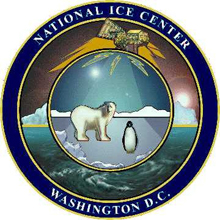About the United States National Ice Center

The National Ice Center is a multi-agency operational center operated by NOAA, the U.S. Navy, and the U.S. Coast Guard.
The United States National Ice Center (NIC) is a unique, tri-agency government organization comprised of NOAA, the United States Navy, and the United States Coast Guard. NIC’s mission is to provide high-quality strategic and tactical ice analysis services tailored to meet the operational requirements of U.S. national interests.
NIC Products
Today, NIC produces literally hundreds of ice-related products, including weekly ice analyses, ice forecasts, daily ice edge products, tactical scale ice analyses, and annotated satellite imagery. Products are made available to customers via a variety of media, ranging from the Web to old-fashioned fax charts. Digital products are also made available for customers to import into Geographic Information Systems (GIS). Unclassified products, such as sea ice analyses and forecasts, are available online. The National Ice Center also operates a SIPRNET, which contains a mix of classified and unclassified products produced by NIC.
NIC Tools
To monitor global ice conditions, NIC makes use of a variety of remotely sensed data sources. Synthetic Aperture Radar (SAR) and visible/infrared imagery from NASA’s Moderate Resolution Imaging Spectroradiometer (MODIS), the Defense Meteorological Satellite Program’s (DMSP) Operation Linescan System (OLS), and NOAA’s Advanced Very High Resolution Radiometer (AVHRR) are the primary data sources used by analysts at NIC. Remotely sensed microwave and scatterometer (QuikSCAT) data are also incorporated in each analysis. When available, information from ice reconnaissance missions, typically performed aboard a Coast Guard helicopter, is also integrated into each ice analysis.
Organization
NIC is a unique organization, not only in its arrangement as a tri-agency government partnership, but also in the scope and range of its products. While other countries possess agencies whose purpose is monitoring regional ice conditions, NIC is the only agency in the world that monitors and analyzes ice conditions across the entire globe.
NIC’s interagency cooperation improves government efficiency by pooling the resources of each partner agency, building on the strengths of each partner, and removing duplication of effort that had existed prior to the merger. A look at each agency’s involvement in NIC shows the advantage of this unique partnership.
The U.S. Navy
The United States Navy provides the majority of the staff at NIC. These positions are filled primarily with Aerographers Mate, whose expertise is weather analysis and forecasting. Naval officers serve in managerial roles and there are also Navy civilian personnel at NIC, many of whom were previously stationed at the Center while serving in the Navy. These Navy civilians, along with NIC’s NOAA civilian contingent, provide long-term stability, organizational knowledge, and continuity that are important at NIC.
The U.S. Coast Guard
The United States Coast Guard (USCG) is both a partner and a customer of NIC. The USCG provides at least one full-time appointment to NIC at all times. The USCG has a strong interest in maintaining navigation safety, thus it is very interested in monitoring ice conditions in the nation’s waterways. In the Great Lakes region in particular, there is a close relationship between NIC and the regional Coast Guard district. The Coast Guard provides ship reports of ice conditions and weather, while NIC provides ice analyses and special products derived from these ice analyses specifically for the Coast Guard.
Additionally, the USCG is involved in monitoring icebergs in both the North Atlantic Ocean and in southern Alaska. The Coast Guard position at NIC is involved primarily with monitoring high-resolution satellite data to observe and track icebergs in the Prince William Sound region of southern Alaska.
NOAA
NOAA, which provides much of the funding for NIC, also provides civilian employees. Although there is only a small NOAA contingent at NIC, these personnel are particularly important as they ensure long-term stability. The NOAA employees at NIC come from NOAA’s National Environmental Satellite, Data, and Information Service’s Office of Satellite Data Processing and Distribution.
In addition to NOAA’s civilian personnel at the National Ice Center, there is one appointed NOAA Corps officer at NIC. This officer heads NIC’s Liaison Branch, which handles customer relations and inquiries, and may also embark on deployments with U.S. Coast Guard icebreakers to provide ice analysis support.
Another NOAA responsibility at NIC is the manning of the U.S. RADARSAT Order Desk. RADARSAT is a SAR system that has proven very valuable for monitoring and analyzing ice conditions. The RADARSAT Order Desk is responsible for ordering RADARSAT imagery for all of NOAA. Because NIC is the single largest user of RADARSAT imagery in NOAA, it is convenient that the order desk is co-located with NIC.
In addition to maintaining the NOAA RADARSAT Order Desk, the NOAA contingent at NIC focuses on U.S. waters containing ice that impacts navigation. One of the primary regions of focus is the Great Lakes region during the winter season. Ice analyses are produced twice a week, and several specialized products geared towards specific NIC customers with interests in the Great Lakes region are also created.
NIC also has a research-oriented Science Team that is headed by a senior NOAA Physical Scientist. This Science Team focuses on research in the polar regions, as well as developing new products that support NIC’s operational mission.
